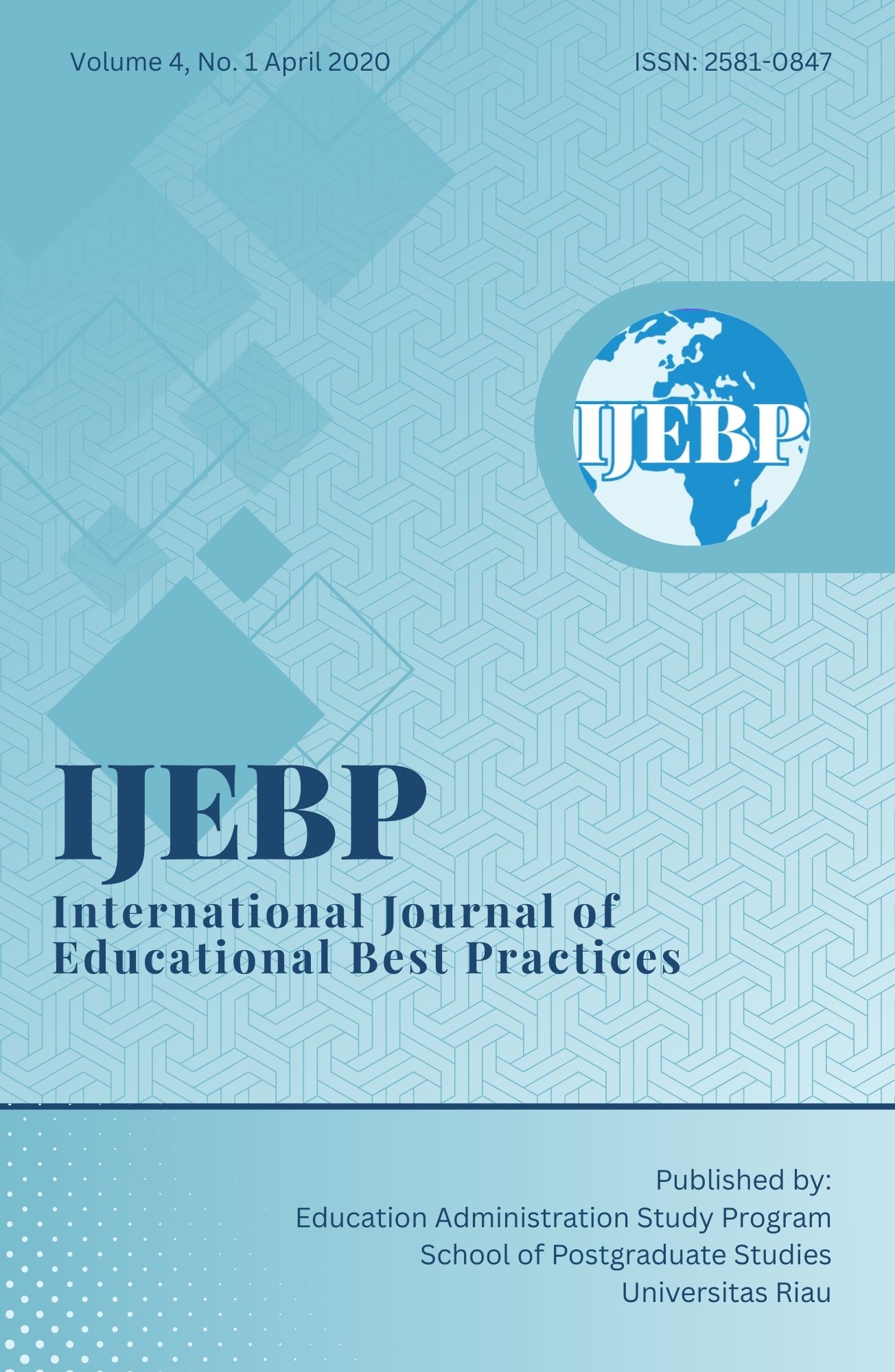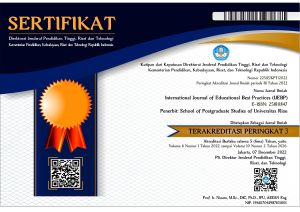ASSESMENT OF PREVALENCE OF EXAMINATION MALPRACTICES AMONG UNIVERSITIES STUDENTS: A COMPARATIVE STUDY OF MALE AND FEMALE STUDENTS IN UNIVERSITIES IN MOUNT KENYA REGION
DOI:
https://doi.org/10.31258/ijebp.4.1.29-42Keywords:
examination malpractice, ethical theory, prevalance, pragmatic, viceAbstract
Stakeholders in education continue to express concerns
regarding the proliferation of students' engagement in examination irregularities in universities in the world and Kenya in particular. Despite the stringent measures put in place to curb the vice, university students continue to engage in examination irregularities. The objectives of the study were; to assess the status of the prevalence of examination malpractices among university students in the Mt Kenya region, and to compare the prevalence of examination malpractices between male and female students in universities in the Mount Kenya region. The Ethical Theory guided the study. A descriptive research design was adopted. Kathuri and Pals' sampling table was used to sample 380 student participants. Data were collected using questionnaires. Cronbach Alpha Coefficient was calculated to establish the reliability of the instrument, which yielded r=0.79 thus higher than the 0.7 thresholds of acceptance. Experts from the department of education validated research instrument. Data analysis was descriptive and inferential statistics. Results showed that carrying unauthorized materials (50.4%), copying of answers (49.6%) and giraffing (50%) were the most prevalent forms of examination malpractices and students did not get leakages as indicated by 84.5% of respondents. The t-test yielded a p-value of 0.720 against the theoretical p = 0.05. The null hypothesis was accepted (at α=0.05). The engagement of male and female students in examination malpractice was relatively the same in universities under study. The study concluded that both gender engaged in examination malpractices. The study recommended that pragmatic measures were needed to control curb the menace.
References
Akaranga, S. & Onyonga, J. (2013). The phenomena of examination malpractice: An Example of Nairobi and Kenyatta Universities. Journal of Education and Practice, 4 (18) 87-97.
Armstead et.al. (1996). Individual Differences in Students Cheating. Journal of Educational Psychology, 88, 229-241.
Borg, W.R., & Gall, M.D. (1996) Educational Research: an Introduction (6th ed). New York. Longman.
Campel. (2013). Educational Psychology in changing world. London. George Allien & Smith Publishers.
Chaminuka, L., & Ndudzo, D. (2014). Students and Staff Perceptions on Examination Malpractice and Fraud in Higher Education in Zimbabwe. Asian Journal of Humanities and Social Sciences, 2(2), 78-90.
Claubaugh, G.K., & Rozycki. (2009). Preventing cheating and plagiarism, Orlando. New Foundations Press.
Duze, A., & Nash. (2011). Schools Cheating Behavior: Rev. Educ. Res. 4, 623- 632.
Ele, O. (2016). The many faces of examination malpractices in Nigerian schools: An Advocacy for improvement of moral standards. International Journal of Social Sciences and Humanities Review, 6 (4) 102-108.
Frankel, J.R., & Wallen, N.E. (2003). How to Design and Evaluate Research in Education. Boston: McGraw-Hill Higher Education
Franklyin-Stocks, A., & Newstead, S.E. (1995). Undergraduate Cheating: Who does what and why? Studies in Higher Education, 20 (2) 159-172.
Kathuri, N.J & Pals, D.A. (1993). Introduction to Education Research: Kenya Education Media Centre. Egerton University Press.
Khan, I., Khan, M.J. &Khan, J. (2012). Teachers’ perceptions regarding malpractices used in examinations in urban areas of District Peshawar. Pakistan. University of Peshawar, Pakistan: Munich Personal RePEc Archive.
Kibler, W. (1993). Academic Dishonesty: A Student Development Dilemma. NASPA Journal, (30). 252-267.
Kothari, C.R. (2011). Research Methodology-Methods & Techniques. New Delhi: New Age International Publishers.
Jagero, N. (2013). How Performance of Students in Kenya Certificate of Primary Education can Predict their Performance in Kenya Certificate of Secondary Education. Educational Research International, 1 (3) 11-19.
Maduabum, D.O. (2009). Ethics and Professionalism in Academics. Paper presented at the Faculty of Education seminar. Nigeria. The University of Ado-Ekiti, Nigeria on 16th May, pp. 2-7
Maheka, G. (2015). Nature and Causes of Examination Malpractices in Selected Secondary Schools in Kituwe District, Zambia. Lusaka, Zambia: The University of Zambia.
Matara, D.S & Namango, S.S (2016). Faculty perceptions of cheating in Examinations in Undergraduate Engineering. Journal of Education and Practice, 7 (30).
Njue, E.K. (2013). Effectiveness of Examinations Policies in Curbing Examination Malpractices in Secondary Schools in Tharaka-Nithi County. Unpublished Thesis, Chuka University.
Njue, E.K. Muthaa, G.M, & Muriungi, P.K. (2014). Effectiveness of examination handling and distribution procedures in curbing malpractices in secondary schools in Eastern Province, Kenya. Creative Education, 5, 573-579.
Njeri, S.W. (2016). Unethical Practices in Higher Institutions of Learning: A case of Kenyan Universities. Pyrex Journal of Educational Research and Reviews, 2 (3) 15-27.
Omari, I.M. (2012).Implications of Examination Irregularities in the Management and Administration of Public Examinations.
Omemu, F. (2015). Causes of Examination Malpractice in Nigerian Institutions. British Journal Of Education, 3 (7) 34-41.
Oyieko, J. (2017). Examinations Rules and Regulations and Examination malpractices in Secondary schools: Student Perception. A case of study of schools in Bondo, Kenya.
Peters, J.S &Okon, O. (2014). Students’ Perception of causes of Examination Malpractices in the Nigerian Educational System: The way forward for quality education. Procedia-Social and Behavioral Sciences (114) 125-129.
Ruto, D., Cheruto, L. & Kimutai, D. (2011). Student Factors Influencing Cheating in Undergraduate Examinations in Universities in Kenya. Problems of Management in th e 21st Century, 2, 1d: 181.
Siringi. (2009). Over 60 % of college students admit to cheating in examinations. The Standard Newspaper. Pp.23-25.





